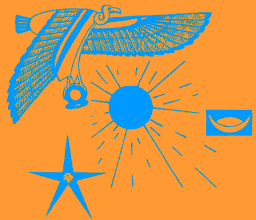Part One:
Calendars, Cycles, and Periods
Chapter One:
Sun, Moon, and Sothis
The Year ... 3
The Month ... 3
Time, the Number of Motion ... 4
Venus and Sirius ... 4
The Julian Calendar ... 5
The Gregorian Calendar ... 5
The Russian Calendar ... 6
A.D., B.C., and B.C.E. ... 7
Astronomical Vs. Historical Datings ... 8
Anno Domini? ... 9
When the Julian and Gregorian Calendars Were in Phase ... 10
The Egyptian Calendar ... 10
The Dawn of Invisibility ... 12
The Egyptian Advantages ... 12
The Egyptian-Julian Quadrennia ... 13
Solar Calendars and Schematic Months ... 13
Luni-solar Calendars ... 14
The L9-year Cycle ... 14
The 25-year Cycle Table ... 15
Sothis ... 15
The Length of the Sothic Period ... 16
The Alexandrian Calendar ... 16
Solar, Or Sothic? ... 17
Retrojections and Retrocalculations ... 18
The Heliacal Risings of Sirius ... 20
Equating Dates From Different Calendars ... 21
The New Day ... 23
Chapter Two:
The 25-year Cycle
Papyrus Demotic Carlsberg 9 ... 24
Sources ... 25
Claudius Ptolemy and the 25-year Cycle ... 25
The Table That is Not There ... 26
What There is in Papyrus Carlsberg 9 ... 27
The Highly Idealized Character of the Table ... 28
With A Running Count ... 31
A Confluence of Uniformities ... 32
Reaching the 9125 Days ... 32
The Implied Lengths ... 33
The 1's and the 30's ... 34
The Placement of Intercalary Material ... 34
The "Great" Years ... 35
Intercalation Not Involved ... 35
The Effect of the Equinoxes ... 36
Computations of the Lunar Months ... 38
Starting-points ... 39
Thoth 1? ... 40
Leaving the Columns Blank ... 41
A Timing Problem ... 42
The Original Cycle Table ... 42
The Autumnal Equinox Again ... 43
Possible Thoth 1's ... 45
The Half-day Shift ... 46
Still Working After All These Years ... 47
Parker's 48 Lunations ... 48
A Sample for Testing ... 49
A Convenient Short-cut ... 49
The Results ... 51
Chapter Three:
Parker and Samuel: An Examination of Their Evidence
The 25-year Blocks ... 52
Filling in the "Missing" Columns ... 52
1 and 30 ... 53
The Advantages of Saying Less ... 54
Parker's Evidence ... 54
The Two Claims ... 56
The Dates That Fit the Cycle ... 57
The "Missing" Phamenoth and Epeiphi Columns ... 58
Cairo Demotic Papyrus 30801 ... 61
Samuel on Parker ... 62
Increasing All of the Dates by One ... 63
Samuel's Evidence ... 64
A Graphical Explanation ... 67
Papyrus Demotic Philadelphia 510b ... 69
The Pithom Stele ... 70
Opting for the Moon ... 71
Chapter Four:
The Rylands Cycle
Papyrus Rylands 666 ... 72
Repeating Cycles and "New Moons" ... 73
A Discrepancy ... 75
First Invisibilities ... 75
The Format of the Papyrus Rylands 666 Cycle Table ... 77
Parker and the Earlier Cycle ... 77
Papyrus Rylands 27 ... 78
"Two Solitudes"? ... 78
Chapter Five:
Theon and the Fifth Year of Augustus
The Ascension of Augustus in Egypt ... 80
-44 ... 81
The Roman Era of Augustus ... 82
The Fifth Year of Augustus in Egypt ... 83
The Ahistoricity of the -25 Starting-point ... 84
The Actual Starting-point of the Alexandrian Calendar 84
Theon of Alexandria ... 85
Martín and Velikovsky ... 86
Chapter Six:
Sirius and the Sothic Period
The Retrocalculated Heliacal Risings of Sirius ... 89
-1321 As the Start of A Sothic Period ... 89
The "Tetrad" ... 90
The Osculating Sothic Periods ... 90
The Egyptian-sothic Quadrennia ... 90
The Egyptian-sothic Triennia ... 91
The Three Triennia ... 92
-756 and -520 ... 94
The Effect on the Tetrads ... 94
The Exact Dates of the Triennia ... 96
Chapter Seven:
Censorinus and the Year of God
The Birthday of Cerellius ... 98
When Did Censorinus Write? ... 99
The Eras ... 99
Calends Xii? ... 100
-1313? ... 101
The Coins of Antoninus Pius ... 102
Parker's "Anchor in Time" ... 102
Chapter Eight:
The Theon Annotator and the Era of Menophreus
"A Formula for the Rising of the Dog Star" ... 104
Martín ... 105
By Round-about Ways ... 105
The Memphis Rising ... 106
The End of the Era of Augustus in Egypt ... 106
The Era of Menophreus ... 107
The Julian Reform? ... 107
What is the Theon Annotator Doing? ... 108
The Errors of the Theon Annotator ... 110
The Sixth Error and Related Natters ... 111
The Identity of Menophreus ... 114
Chapter Nine:
The Venus Year
The Retrocalculations of Venus ... 115
The Velikovsky Divide ... 117
The Star of Isis ... 119
The Venus Year ... 120
Events on or About Thoth 1 ... 120
The Backsliding of Venus Through the Egyptian Calendar ... 120
Western Disappearances At the Beginning of Thoth ... 121
Western Elongations At the Beginning of Thoth ... 121
The Morning Star and the Nile Flood ... 122
The Approaching Crisis in the Third Century ... 123
The Timing of the Canopus Decree ... 124
1461 / 4 = 365¼ Days ... 124
The Anticlimax ... 125
